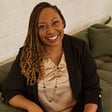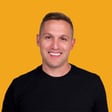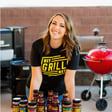Become a Creator today!Start creating today - Share your story with the world!
Start for free
00:00:00
00:00:01

Founders' Series - Gavin Wade - Building CloudSpot
Today’s guest is Gavin Wade, the founder of CloudSpot, a photo gallery solution for professional photographers.
CloudSpot makes it easy to load, organize and share your images with clients, and it's actually what we used in our photography business. In the episode, we get to hear about Gavin’s journey from fitness professional, to wedding photographer, to founder of a software company, and the challenges that Gavin and his team have faced and overcome throughout the last few years. One thing you’ll pick up about Gavin is that he’s not scared to take a risk and pursue an idea, even if there are some serious challenges to tackle.
For the show notes and additional resources, go to https://daveyandkrista.com/btb-gavin-wade-cloudspot-fs.
Transcript
Importance of Experience and Processes
00:00:05
Speaker
You don't learn those things necessarily by just reading a book. It's a hardcore experience, and it starts out small. It starts out with duct tape and chewing gum and all that kind of stuff, and then you start building in these systems and processes as you need them to get there.
Introduction to the Podcast
00:00:24
Speaker
Welcome to The Brands That Book Show, where we help creative, service-based businesses build their brands and find more clients. I'm your host, Davy Jones.
Guest Introduction: Gavin Wade
00:00:36
Speaker
Today's episode is part of the Founders Series, where we chat with founders and CEOs of companies that have created products and services that help creatives run their businesses.
00:00:47
Speaker
Today's guest is Gavin Wade, the founder of CloudSpot, a photo gallery solution for professional photographers. CloudSpot makes it easy to load, organize and share your images with clients. And it's actually what we use in our photography business.
Gavin Wade's Career Journey
00:01:00
Speaker
In the episode, we get to hear about Gavin's journey from fitness professional to wedding photographer to founder of a software company. And we get to hear about the challenges that Gavin and his team have faced and overcome throughout the last few years.
00:01:13
Speaker
One thing you'll pick up about Gavin is that he's not scared to take a risk and pursue an idea, even if there are some serious challenges to tackle. Before we get started, CloudSpot is offering 25% off any plan for the first year and free image migration. Yes, that's right, free image migration. Just use the code BTBSHOW when you sign up. And that's not an affiliate link. We don't get anything for you signing up. We're just recommending a product that we've used and appreciated.
Audience Interaction and Feedback
00:01:41
Speaker
Be sure to check out the show notes at daevianchrista.com for the resources we mentioned during the episode, and I'd like to hear from you about what kind of content you'd like to see on the Brands at Book podcast as we move forward. I'd also like to know what episodes you've enjoyed most so far and why. To leave your feedback, head on over to the Davian Christa Facebook page and send us a message.
From Photographer to CEO
00:02:00
Speaker
Now, on to the episode.
00:02:10
Speaker
All right, today on the show, we have Gavin Wade. And Gavin started as a photographer, but he is now the CEO and founder of CloudSpot, which is the actually online gallery solution that we use to deliver our galleries or that we previously used to deliver our galleries to our clients. And I say previously, only because we're not shooting anymore. But all of our galleries still live on CloudSpot. So welcome to the show, Gavin. Hey, thanks, David. Good to see you, man.
00:02:38
Speaker
Yeah, and I was pumped that we got an opportunity to meet each other in person for the first time this past year at Show It United. It was awesome to see you in person, but then also to talk with you a little bit about what's been going on in development for CloudSpot.
CloudSpot's Development and Updates
00:02:56
Speaker
I got to pick your brain because I feel like CloudSpot's one of those companies that's always rolling out new updates.
00:03:03
Speaker
It's like every day in the CloudSpot Facebook group, I see, hey, we just released the online version of CloudSpot. I know that was a big release, the web version recently. And then beyond that, now there's new integrations rolling out, all sorts of stuff. So I'm excited to dig into that with you and talk maybe even a little bit about how you're able to get so much done in what seems like such a small amount of time. But I don't want to jump the gun. Can you tell us a little bit about
00:03:33
Speaker
how you got started. Yeah, absolutely. And just to echo what you said, it was great meeting you guys officially, they're a show united. Although no offense, your little guy kind of stole the show. He's definitely the highlight now, you know?
00:03:47
Speaker
But yeah, absolutely. We'd love to just kind of share the background of where Klotzbach came from. Like you mentioned, my wife and I were photographers. No, we still are. We still shoot weddings and family portraits. We just dialed it back a lot. But we started out not as photographers together. We were dating. We had met on eHarmony. It was kind of one of those super weird things where the internet glitched and we got matched up together.
Transition to Photography
00:04:10
Speaker
We both had our day jobs. We both had our degrees and we just, one night we're sitting at dinner and we just weren't loving our day jobs at all. We were griping. We were complaining. We were in our early twenties at the time. And I just looked at her and I'm like, Hey, like, you know what? We don't have to be stuck in this for forever. If we don't want to, like we are at this point in the life. We're still living at home. We can make some dumb decisions. Still, we've still got some time left. You know, if you could do it all over again, what would you want to do?
00:04:36
Speaker
And our answer was the same thing. It was photography. And we had no previous photography experience. I had known some photographers. She had known some, we had kind of messed around, but like nothing official. And so we said, well, let's give it a go. So I reached out to a photographer friend.
00:04:52
Speaker
Ended up going to a little conference in LA a few days later. Right after that was done, we sunk our life savings into camera gear, which, you know, when you're 22, your life savings is like one camera body. It's not glamorous, but we got enough to get us into trouble in the photo world. And we said, look, let's start learning. And so we went to workshops. We took an intensive class. We started investing into that side. And so our dating life, you know, was pretty unique because every time we were together, it was pretty much working on a business that we had started together.
00:05:22
Speaker
And then when we got married 13 months after first starting our photo business.
00:05:26
Speaker
As soon as we got back from our honeymoon, we quit our day jobs. And so we were doing photography full-time ever since then.
Challenges of Starting a Business
00:05:33
Speaker
There is so much to unpack in, you know, just those short few minutes that you gave it over. I mean, first, one, starting a business is stressful. I mean, and Chris and I, I think we have a great relationship and a great marriage and, you know, but even with that said, I mean, it's tough sometimes working together, right? I mean, there's, I mean, I guess I should say there's challenges there.
00:05:54
Speaker
So you're starting a business with your girlfriend at the time. Girlfriend. Yeah. No, no commitment. No, nothing. I'm not saying I'm going to marry you. Nothing like that. We are just like, hey, let's start this thing. But you know, between you and me, I already knew I was going to marry her. Yeah. But it was just one of those things like, let's give it time.
00:06:11
Speaker
But yeah, our relationship started off pretty darn interesting, not your traditional one for sure. Yeah, awesome. And so what were you all doing before photography? So my degree is in kinesiology. So I was doing physical therapy, personal training. I was actually a fitness consultant at that time for Taco Bell, believe it or not. I guess they need one, right? Yeah, talk about job security, right? But they actually have in their Western headquarters here in Southern California, they have a gym on the first floor of their 20-story office building.
00:06:40
Speaker
And so I was the personal trainer in there that was training all their employees. And they just so happened to be right across the hallway, a huge food court of every single fast food joint you could think of that Taco Bell owns. So yeah, my clients would come right out of the gym and go right into the KFC food court. But it was one of those things where I was doing training. I was loving the fitness world, but I was kind of at that point where I was like, I'm either going to invest in going back to school, getting a ton more debt and doing like the doctoral physical therapy degree.
00:07:08
Speaker
or not. And my wife, she had a degree in neurological psychology. So she was either going to do family counseling. She actually owned her other business at the time. She was a massage therapist as well. And yeah, it was just, it was a grind, man, but it was a grind for somebody else and not really for, you know, us. And so we were just kind of just wondering like, Hey, if we're 50 years old, 60 years old, like, is this something that we're going to find a lot of joy in? And the answer was no. And so we said, well, what will give us joy? Or what will at least light a fire underneath us? And so
00:07:37
Speaker
The decision was definitely not popular with the parentals at the time when I informed them that just months out of college that all of that wonderful student debt they had racked up on my behalf was going to not be used whatsoever. So there were consequences of that for sure. I got kicked out of the house and I got an ultimatum of, you know, you got to pay all your student loans back now if you're going to make a big boy decision like that, but I didn't care. So yeah, we're going to go, we're going to do it. So yeah, it took about a year and a half, but we shot about 28 weddings in our first year of dating.
Building a Photography Business
00:08:07
Speaker
By the way, and then when we got married, we shot anywhere from 30 to 50 weddings a year after that. Okay. Wow. That's awesome. And did you all primarily shoot your weddings together or did you split up or a little bit of both? Always together, always together pretty much since day one. And as you mentioned, there are challenges and I would even say it's not easy sometimes because two different people, I mean, we had the benefit of building our business together, but if you come, you know, into a relationship and you already have preconceived notions about how my business is run and how your business is run.
00:08:37
Speaker
There's definitely going to be, I would feel, a bigger clash there. But, you know, we very early on kind of divided the responsibilities in terms of what we enjoyed. I hated editing. She loved it. I hated design. She loved it. She hated all the techie stuff like website, SEO, all that kind of stuff. I loved all the camera stuff. So the emails and the client communications. So, you know, the lines were drawn pretty clearly there. And so, yeah, I mean, it was great working
00:09:06
Speaker
shoulder to shoulder with the person you love more than anything in the world.
00:09:11
Speaker
together and where it succeeds or fails, that experience alone is pretty freaking cool. Yeah, that's awesome. Chris and I, we tried shooting apart a little bit, but it's pretty stressful not shooting together. We did that for a very short amount of time before deciding that we're going to shoot all of our weddings together, but it sounds like good match between you and your girlfriend at the time, but eventually your wife and 50 weddings a year. That's like almost every weekend a year.
00:09:39
Speaker
We had double triple headers sometimes and we only did that one year and we didn't do anything differently in our business but it just so happened to coincide with the year that we decided to start cloud spot and we were self funding that ourself while we were busier and the business and never been doing better all of that was going straight into another dream.
00:09:59
Speaker
And so we had never been at our poorest, I guess you could say than that year of shooting 50 weddings, but we were building something else. And so that was equally as energizing. Sure. So I do want to ask you one question about your photography business because you guys just, I mean, catapulted.
Networking and Client Building
00:10:14
Speaker
I mean, it seemed to go from zero to 60 pretty quickly. What was it or what would you attribute that to being able to book so many weddings in a relatively short amount of time and really kickstart that business?
00:10:27
Speaker
Yeah, for us, and this was back in 2008, something like that.
00:10:33
Speaker
So the world of photography was quite different. This was before really social media had become such a key factor. So for us, it was a lot of people in our age group at that time were getting married. We're kind of right within our network. We're looking for somebody. So between the two of us, we had known a lot of people and kind of got that word out there early saying, hey guys, this is what we're doing. We'd love to be a part of whatever journey that you have as a couple or offering style shoots or
00:10:58
Speaker
Second shooting a ton so while we shot probably 20 something weddings our first year I actually shot 50 plus weddings that first year because I was second shooting a ton as well so I would say it was equal parts referral from those photographers that I had been shooting with who were booked and People just in our network who are just getting married because it's that that age range and so that helped us in that first year and then the second year were primarily referrals from the first year and
00:11:23
Speaker
Yeah, that's awesome. And one thing, I mean, I think people overlook second shooting. If you're a service based business, you can generally, you know, you can only scale so much, right? Like if you're working a wedding on a Saturday, you can't work another wedding on that on that Saturday. And so Krista also when she was first starting your business second shot a ton in that first year, and those photographers, she built, you know, a level of trust with the photographer she was working
Improving Client Experience
00:11:44
Speaker
with. So those photographers that she worked with and was seconding for
00:11:47
Speaker
trusted her enough that when they were booked, they would send those inquiries to her. And that really I think started getting that initial client base and then eventually you get word of mouth from those clients and it just hopefully continues to cycle on. So that's awesome. But I do want to dig into CloudSpot as well. Could you, okay, so could you real quick paint the picture of I guess what was currently or what was out there
00:12:13
Speaker
back when you started CloudSpot. And I assume that has that will give some insight into why you wanted to create CloudSpot. Yeah, yeah. So, you know, CloudSpot came from really me since I was in charge of all the techie stuff in our business, I was facing a ton of hurdles when it came to delivering images to our clients. Second only by when I did deliver those images, the experience that those clients had. And it was terrible. I mean, again, 2008 technology has changed a lot. So thankfully, things
00:12:42
Speaker
are better and there are better solutions. But at the time, there was only a few companies in our space that had even really tried to do it. I can name names and I won't bash them, but it's more like these are the companies that were in our space. It was Pass, SmugMug, ZenFolio, and Pictage. I don't know if you remember Pictage. Very vaguely. Very vaguely. And ZenFolio, I didn't even know. Are they still around? They're still around. Yeah. Okay.
00:13:11
Speaker
But at the time it was more, and I guess there was shoot proof there at the time as well, but they were a very fledgling company back in 2008. But they were the website slash proofing slash sales companies that were out there. Pass was the new kid on the block, but was so cost prohibitive for us as a business because of the volume that we were doing, it would have cost us multiple, multiple thousands of dollars to do it. And that just didn't make sense for us. So I was using SmugMug at the time.
00:13:36
Speaker
I was just copying and pasting probably 15 links to our client when we would deliver images to them. And it just looked horrible. It took a ton of time. It wasn't good for them. It wasn't good for us. And at the end of the day, it just felt like a, hey, here's a bucket full of links, like have a nice life, you know? And that's terrible. I mean, when we were a referral based business in our first two years, like those relationships were precious to us and we did not want it to feel like we were just merely
00:14:04
Speaker
giving them to a third party just to get them off of our to-do list and then move on to the next one. We wanted to be proud of it. We wanted them to feel like, hey, look, they just invested thousands of dollars into us. Why are we giving them an experience that is not reflective of that at the time when their experience with us should be at its high point when we're giving them their images? And I gave them 10 links to download that would take them 20 minutes a piece just to get their photos. It just wasn't good. So over dinner one night, I just looked at Aaron because I was,
00:14:32
Speaker
I was complaining a little bit about my workload because of things were bottlenecking on me because she's so crazy fast at editing. It's annoying. And I was just like, I need there needs to be a better way. I was like, I got vendors asking me to send a few images here and there. I've got clients that need all these photos. I'm trying to get images to people like second shooters and stuff like that. This this is just, you know, that Internet speeds at the time were just not good. And it was just it was a mess. So I looked at her and I said, hey,
00:15:00
Speaker
Can I go for something? I don't know software development. I wish I were that smart. But I'm like, you know, I have an idea. Can we chase it down? How hard could it be? Right. And so she's, you know, amazingly believed in me and said, yes, absolutely. Let's let's do it.
Supportive Role of Gavin's Wife
00:15:18
Speaker
So.
00:15:18
Speaker
that was four and a half, almost five years ago. Okay, awesome. So what was 2013 ish? Something like that. Yeah, when the scribbles on the back of the napkin, their dinner kind of started turning into legal pads worth of scribbles and UI UX design. And then I had to find developers and you know, around the world and started self funding that and project managing that and trying to get it into beta and
00:15:41
Speaker
you know, just all the joys there and learning experiences. Yeah, and I want to jump into those challenges here in a second because software is for sure its own its own beast. But before that, first, I want you know, it seems like you have sort of this history of coming up with these these grand ideas and, you know, and going after them, which is awesome, taking those risks, starting with the photography business in the first place. Is your wife a similar personality to you?
00:16:06
Speaker
Yes she she is a type a person to the max so if you watch friends at all she is a monica and i'm a chandler if you were to classify so she has lists for her list and she's the type where she'll just sit down and she will edit a whole wedding within. Two days but she'll just go for it and yeah.
00:16:26
Speaker
pound it out and move on to the next. Even when we were shooting two, three weddings a weekend, they were all done by the time the next weekend's weddings rolled around and sent out. I wasn't kidding. When the things were bottlenecking on me on the tech side because she was just going so fast and doing such a great job,
00:16:44
Speaker
That, you know, there's needed to be a solution. So yeah, she definitely is, is the wind beneath my wings for helping me chase crazy ideas. And she's the one that really allows me to kind of stay on point. Like, you know, while we've been building cloud spots, we're still shooting, but guess what? Like I, I show up, I shoot the day, but she handles everything else. And now because of cloud spot, she handles the techie stuff, which is amazing. So, you know, this started out as a purely.
00:17:07
Speaker
Selfish endeavor I guess just to get the workload off of me and get it to her but she's taking care of it She's doing great and now we have a little one as well who's two and a half and so we've seen big changes and need to happen to our business because you know, she's a mom and that is her passion that is what she wants to do and you know God bless her
Vision for CloudSpot
00:17:26
Speaker
for doing that. She's doing an amazing job and helping me, you know support me in both areas. So
00:17:31
Speaker
Yeah, yeah, that's awesome. Krista wanted me to take on the editing when I joined her full time in the photography business. And I was too slow for her. Yeah, so so she took that back. And she did it because similar to your wife, she could just she could knock it out so quickly and so efficiently. And there's no shot even if I put years into it probably in catching catching up with her. But when you first envision cloud spot, what was kind of the initial vision for it? And how did you see it differing from you know, the competitors already out there?
00:18:00
Speaker
Yeah. Yeah. So there's two points where I really saw like, look, this needs to change. First, the client experience. So the email that they would get from this service.
00:18:12
Speaker
needed to look like it came from their business. It should not have looked like it was from a third party that maybe just had a little logo up in the top or something. It needed to look like it was from me. Like, I wanted it to be that, like, wow, my clients get this, they go, wow, Gavin and Aaron have a service all of their own. They have created this thing just for us, unique to their business, because I feel like that really makes an impression. Second, when it comes to delivering images, everybody was being sent through the galleries to download things or to request a download.
00:18:41
Speaker
And there was just a lot of hurdles in that in order to make that happen because once they would request it, they would get 10, 15, sometimes 20 download links sent to them after they requested it.
00:18:53
Speaker
And that was just really tough. And there was just a lot of barriers between, it just didn't make sense to me that, you know, your client would get an email, they would click a button, they would go to a gallery, they would click another button, they would enter their email address, they would wait 15, 20, 30 minutes, they'd get another email, not from the photographer's business, with more buttons. They click on those buttons, it takes them to another webpage with more buttons, and then they can finally start clicking and downloading. And that just didn't feel like a good experience to me. That felt like I was asking for trouble.
00:19:20
Speaker
And I just said, look, why isn't there just a way for me to send one image, two images, a whole batch of images, a whole folder of images at any size with or without my watermark in a beautifully branded email. And right there in the very first email, a download button should be visible to my client to get exactly what they need from me. Like if I could build that experience, that's what I would want it to be. And so those are the two main things that we set out to do with CloudSpot and what
00:19:48
Speaker
The third thing that kind of came about very shortly after was I don't want this experience even online in the gallery side of things to look like it's coming from a third party. I don't want there to be some funky name in the URL. I don't want there to be some forced branding or whatever it might be. I want it to look right out of the box just like it's from my business. And so those are the three key things that we tackled when we started building it.
00:20:11
Speaker
Yeah, I like what you're focusing on because I think it was true then, but there are also things that are certainly true now and will be true 10 years from now. You want to focus on client experience and the experience that you're giving your clients when they go to download and use.
00:20:28
Speaker
For those of us who are maybe a little bit tech savvy, we sometimes underestimate or overestimate rather how easy something is for somebody else to complete. So being able to offer a seamless experience to our clients is super important. And along those lines, branding, I think is a big one. Sending stuff over to your clients that makes you look like a professional because it's your brand, not some other company's brand.
00:20:52
Speaker
So I really like that. I love how you have this vision, but now let's talk about the execution of the vision. For software in general, it's a different beast. For those of us who have started service-based businesses, when you started your photography business,
00:21:08
Speaker
you went and you bought, the barrier to entry is pretty
Challenges in Software Development
00:21:11
Speaker
low. I mean, I know that the equipment costs thousands of dollars, right? I mean, to start, but you can get a semi-professional camera for maybe and the lenses you need to go shoot your very first wedding for probably a couple thousand dollars, right? For sure. Software, if you want to develop even a relatively simple app solution, it's going to be more than that couple thousand dollars.
00:21:37
Speaker
And then beyond that, when you go to build things, it's not like you can just tack on features. And it's hard for me to explain. You probably articulated a little bit better. But one conversation we had at United was that you guys had just basically created this
00:21:55
Speaker
new awesome API months of development, but something that happens behind the scenes that I guess I could empathize that you probably put a ton of effort in, but nobody's really going to know that because it's not a front facing thing. The foundations that sometimes go into development, nobody sees all that work. They only see the tip of the iceberg
00:22:18
Speaker
which is whatever the consumer facing portion of that is. So I just have a lot of respect for you all who have started software companies like Showit and we had Nate from Sticky on here as well. So anyways, tell us what were the biggest challenges in creating CloudSpot? I guess it just depends on what phase, because it feels like every other week, it's a different set of challenges. I love the challenges and
00:22:44
Speaker
as you put it, you know, the tip of the iceberg is what everybody sees. And that's kind of on how you're judged, right? And I guess perception wise in the industry. But yeah, like we talked about, we spent seven months working on something behind the scenes that if executed perfectly would change absolutely nothing on the client side of things for photographs. But yet behind the scenes, everything changed. And there were actually more lines of code in that
00:23:12
Speaker
change than the entire web application and client gallery side of things of CloudSpot combined. But it's just one of those things. But we know that setting that foundation is so key and not necessarily for where we are now. When you're first getting started and trying to get a beta out there, you absolutely need to build this monolithic thing that you try and go fast, you try and get a minimum viable product out there, get feedback as quickly as possible.
00:23:37
Speaker
But then once you start getting traction and once you start getting beyond that product market fit side of things, then it completely changes in terms of what the expectations are and what you need to be looking at. You can't be looking at just 10 feet down the road. You've got to be looking at 100 yards down. You've got to be looking at five football fields away to certain degrees when it comes to architecture of a system like that. You don't learn those things necessarily by just reading a book. It's a hardcore experience.
00:24:07
Speaker
It starts out small. It starts out, you know, with duct tape and chewing gum and all that kind of stuff. And then you start building in these systems and processes as you need them to get there.
Remote Team Management
00:24:17
Speaker
So for challenges for us in the early days, for me, because I was not a developer, the challenge was finding someone to actually just start to break ground, to understand what the vision was and for me to trust that person. And then that one person turned into a few people and that few people turned into, I think at one time we had 10,
00:24:34
Speaker
developers working on CloudSpot at a given time all over the world. So it's a hundred percent remote. And so we, you know, and that was my all day, every day endeavor while we were doing photography. So the challenge for that was finding good talent. And the lesson learned there was you get what you pay for it. When it comes to develop, there really are no shortcuts that will actually pay off. And that respect, you know, if you find somebody who can say, Oh yeah, I'll do it for X amount. I don't take the X amount of time.
00:25:04
Speaker
be wary because, you know, I initially got quoted for CloudSpot to be created in general, end to end my whole vision. Like, Oh yeah, this person's like, Oh yeah, it took me five months and like $35,000. And I was like, Oh shoot, that's fine. We could do that. Like no problem. Yeah. It didn't take that long and it didn't cost that much, you know? Yeah. So, so, you know, it's learning lessons there. And so it's all about kind of
00:25:32
Speaker
same expectations, it's all about making sure that you're always working towards prioritizing the very best thing for that particular time and those particular challenges. Even for companies, I have massive respect as well for companies where people are like, oh, this company hasn't done anything for weeks or whatever, months. I'm like, well, no, they probably have. They're probably tackling a whole bunch of other things that you just can't see or they're prepping and preparing for something that will help catapult their vision forward even more.
00:26:01
Speaker
It's a day-to-day thing and you are only as good as the people that you surround yourself with. So I feel very fortunate to have great folks on the CloudSpot team and a great community of photographers as well because, gosh, everybody shows up here every single day to serve the amazing industry that we love so much and do our very best.
00:26:19
Speaker
Yeah, so it seems like today you guys are a well-oiled machine and you're constantly rolling out with new fun stuff, beyond what people would expect from a solution like yours. But in that time period, like you said, it didn't take five months and $35,000 to build. It was a matter of finding the right people to help you actually bring this vision to life.
00:26:43
Speaker
What, you know, like, if I were to blow, not the blue $35,000, but if I got to the end of that $35,000 road, you know, I would be pretty wary of continuing down that road, you know? So what are some of the things, I guess, that kept you going beyond that, you know? Like, I'm guessing at the end of five months, you didn't have, you certainly didn't have CloudSpot as it is today, right?
Perseverance and Motivation
00:27:07
Speaker
No, we didn't even have an MVP. So what was supposed to be five months turned into a year and a half.
00:27:13
Speaker
So, and even then we had a beta. And so after that, it took a number that had a few more zeros beyond that 35 to even get an MVP out there. And, you know, and there were, you know, there's, as we're growing and as we were scaling, you know, there are things that just had to be redone, you know, and we had to be optimizing our systems. But what kept it going is quite honestly, knowing that this was needed, knowing that there was
00:27:40
Speaker
a group of people out there that had this same problem. And it was belief in the fact that this problem needed a solution because if I didn't feel that way, then I would not have invested what we did. I would not have spent the time we did. I would have not have sacrificed the time with my wife, the time from friends, the time from chasing something else. So I think as a CEO or as an entrepreneur, as someone who's starting your own thing, there's going to be so many, so many
00:28:10
Speaker
times where the world or even people will tell you that, look, hang it up, man. Like this doesn't seem realistic. This doesn't seem, I don't see the end game here. What are you going for? Like these 10 things went wrong and you're waiting for this one thing to go, right? Like how, how does that make any sense whatsoever? And, and in reality, it probably doesn't. If you're coming at it from a purely, you know, logical way, if I put my Spock ears on for a second, it probably wouldn't make any sense.
00:28:40
Speaker
But it's belief in what you're going to accomplish and not what's going to happen next month or next week, but what your true vision is for it. And, you know, that's not to say that I have this big, huge, clearly perfect vision at the very beginning or even now, but it's knowing that there are people that we can help with this. And even if it's just a pocket full, and even if this is just a nice little business that people can truly just be a part of as a community, then we're going to do it.
00:29:07
Speaker
And so we just kept having that belief. You kind of have to, as an entrepreneur, always have that glass half full mentality, even when everybody else is thinking you can't.
Launch Strategy and Customer Base
00:29:17
Speaker
And so, yeah, it's kind of putting the blinders on and truly believing in what you're setting out to accomplish.
00:29:24
Speaker
Yeah, I feel like there's certain aspects of Todd's story which show it that I am calling to mind here. So it's really interesting. I think it's easy to gloss over those challenging aspects of the story while we retell it. But I think it's just so nice for people to hear that. Your perspective, Todd's perspective, other people who we've had on the show, their perspectives from how they dealt with those challenges for motivation. Just a reminder that sometimes
00:29:53
Speaker
the noises that they hear from the outside, they need to shut out and not listen to and keep their head down and keep working and keep going. Eventually though, so one and a half years later, two years later or so, you have an MVP. From there on out, what was the goal? How did you start acquiring your first customers?
00:30:12
Speaker
You know, as part of being in this industry, I had friends and I said, Hey guys, can you give this a shot? Like it just started with my inner circle here in Southern California. Just like, Hey guys, do you mind supporting the home team a little bit here? Like I need some feedback. I need some help in terms of building what you want to see next. I've gotten to the point where I think this is what is a good starting point that solves a couple of key problems. But where did we go from here? And you know, a couple of other companies had sprouted up since, you know, I had started actually.
00:30:40
Speaker
You know, when we were first launching in beta, another company went live, you know, and their timing was amazing, you know, and we were a few months behind that, regrettably, you know, and there was a lot of, you know, a lot of things that we learned from that in going forward. So, you know, we just started growing our sphere slowly, slowly, slowly, you know, and that's kind of been the trajectory of our business ever since. It's just slow and steady with fiercely loyal photographers who are in our community who have that problem. And I'd say if you're going out to build something,
00:31:09
Speaker
Building something for the masses and trying to have it to apply to everybody is going to be a wrong approach in your first days. You need to niche down to find that one subset of the subset of people who you just absolutely blow away and have those fiercely loyal folks. I think it was either Seth Godin or another awesome entrepreneur who said, you know, don't go and find a million people who kind of sort of like what you got. Go find a thousand people who absolutely love it and can't live without it.
00:31:37
Speaker
And that's the foundation on a business, on a good business should grow. And that's when you really kind of have that proof of concept that look, we're on to something here. And, you know, we didn't catapult to huge, you know, numbers overnight. It was year after year after year, you know, we got some, we lost some, we weren't able to apply to every single business and we knew that and that's okay. But guess what? The ones that we did.
00:31:59
Speaker
we were working really hard to make it even better. And then kind of as our feature set grows, and as it continues to grow, we know we'll be able to bring more and more awesome businesses into our community. So that's been the approach. Yeah. So over the last couple of years, especially since I mean, since that MVP beta just launching to your kind of inner circle of friends, what would you say like the big milestones have been for CloudSpot? I would say
00:32:22
Speaker
probably getting it out there into the world, launching it. Oh, for sure. And then getting that initial set of customers, getting that feedback, rolling on that feedback, and then learning how to best
00:32:35
Speaker
Manage because when you're building something in a silo, you know kind of in the shadows. It's really easy You can go all cowboy and make a change and then do it real fast and then keep going but when you have actual users you're getting a flood of feedback coming in and then you're also having a flood of things you want to do and so then all of these bugs that you never thought were even possible might be coming in because guess what people use your software different than you do timing and
00:32:59
Speaker
time again. And they have different platforms, they have different network connections, they have different everything, right? Some people don't even use a mouse, some people use a pen tool, like all those types of things that you just can't necessarily see coming end to end that are now coming flooding at you as well. And I would say, you know, because, you know, we were in a tech incubator for a little bit after CloudSpot launched, and a lot of companies hadn't been out in a release yet, we're not in revenue or anything. And, you know, they were stressing out and like, oh, my gosh, we just got, you know, working on our product,
00:33:28
Speaker
And when they would launch, it'd be really fun to see like just their whole attitude change. Like, man, I thought the work was over when I finished that product and got it out there. The work is just beginning. And quite honestly, when you have hundreds.
00:33:43
Speaker
thousands, however many people coming at you in the opposite direction saying, hey, look, I need this. I want that. Do this. Do that. It's so important to stick to your guns of what you believed in before you even press that big green button to send it live of, hey, what are we building this for? Who are we building it for? And what are we set out to accomplish? And staying laser focused on that is going to be key in getting you through those initial times because you can't please everybody, which is fine.
00:34:08
Speaker
But you can stay true to who you are as a company and who you're serving. And you're either going to attract or repel. And the hope is you do both of those very quickly to allow you to keep growing.
User Feedback and Product Focus
00:34:18
Speaker
Yeah. And I think one of the things that I love about the software companies that I love is that they focus on the must-haves. They're laser focused on what features they roll out for whatever that app is. And they don't go
00:34:34
Speaker
They don't go off and try to build crazy new things that would basically be a new solution. How does CloudSpot cut through that noise? Because you're always going to get user feedback. And honestly, some of it's probably not very good. Not in terms of like, oh, they're giving you, they're being negative about CloudSpot, but just the idea is not very good. It doesn't fit within the division of CloudSpot. It wouldn't be beneficial for those
00:35:00
Speaker
core CloudSpot users that you're trying to build for. So how do you figure out like, okay, what feedback should I focus on next? Because you probably at any given time have well more than a dozen things that you could do. So how do you figure out what's next? Absolutely. I would say three dozen things that we could do. And that's part of being in an industry where there are companies 10, even 15 years older than you out there. And so, you know, when we're,
00:35:26
Speaker
Pretty much as photographers, if we gain a new photographer in the Cloud Spock community, it's not because generally they're brand spanking new and they've never had a gallery service before. They're actually coming to us from another gallery service. Having an online presence is pretty much the status quo for photographers, so very rarely will we have someone coming to us from just like a Dropbox. Although when they do, that is our bread and butter that's blown away, right?
00:35:49
Speaker
But yeah, for other folks coming in, they're like, hey, I need this, I need that. And we say, hey, totally get it. We're working on that. That's part of who we are. But guess what? You came to us for a reason, and here are those reasons. And this site can leverage those to create that amazing experience, to have that workflow optimization for you, and to allow you to make this aspect of your business something that you can be even that much more proud of. Because you came to us for a reason.
00:36:13
Speaker
We love feedback. We always promise to listen. That's core to who we are. But sometimes it might not fit within what we want to do. The example that you mentioned earlier was when we transitioned from a desktop application to a purely web-based application. That was the absolute best move for us to make. But guess what? I can't tell you how many messages we got from our existing users who we love dearly, who had been with us from the very beginning saying, you guys, this is horrible. I don't like it.
00:36:42
Speaker
Like, you know, change is bad, you know, all this kind of stuff. And I get that, you know, it's like, look, we are growing just as you are growing. We hope you'll support us in that way. If you don't like it, I totally get that. I'm sorry. Hey, here's the things that we are doing. Here's the ways that we are working for you. And, you know, at times that negativity, you know, as a founder, sometimes you're really, really close to it, right? And I'm removing myself as time goes on a bit more from that, because sometimes the negativity can be deafening.
00:37:10
Speaker
And that's not because the positivity isn't there, but just those squeaky wheels sometimes can get into your ear. And whether you're running a software business or whether you're running just a wedding photography business, not just, but running a photography business where it is just you with your one-on-one clients, guess what? You get one bad review or you get an unhappy client through no fault of your own. Or the unhappy family member of a client that's not even your client, right? Exactly. But that's what rings over and over in your head.
00:37:38
Speaker
It's a you and you know and we pour our heart and soul into our business and so when something like that comes back it is almost impossible not to take it personally.
00:37:48
Speaker
at first and so it's building that thick skin, it's being true to who you are and it's realizing sometimes that you cannot please everybody and that is okay because if you are trying to please everybody when you're building a business, you're not building that business for you anymore, you're building it for them and that's huge in terms of sucking the joy head of why you started it to begin with but also who you started it for and that's just so core to having joy within the process and not having as many gray hairs along the way.
00:38:16
Speaker
Yeah, and I would say if you're building a business for everybody, you're probably not building a remarkable business. You're not building a business where people are going to be really excited about you and what you do. Maybe that's a good segue into where have you found the most success in acquiring customers for CloudSpot?
Community Engagement Strategies
00:38:33
Speaker
In the last couple of years, you got the wheels on the bus. What have been the most affecting marketing channels for you all? That's a great question. I would say
00:38:42
Speaker
Not what you would probably think. And, you know, photographers are like, oh, conventions, big trade shows. That's where you've got to get all of your users. Right. You need to be there. If you're not there, like that's a big, that's a big miss. That's probably the most inaccurate statement. I thought that's what we needed to do. Right. In the early days, even when CloudSpot was just in beta, because we missed a dev milestone and we didn't launch in time for WPPI years and years ago, but we already had a booth space. We had already built the booths, you know, some way too much money to a custom booth.
00:39:11
Speaker
that took hours and hours to set up and all that kind of stuff. And guess what? We had people who were interested, but we had maybe a dozen people actually buy. And so I was like, well, why? And for software, I think it's different than, let's say, products or things like that that you need to hold and feel and try. But for software, there's a much longer sales cycle for that in terms of someone getting a demo, having their specific questions answered, and having the time to explore that. And when you're on a busy trade show floor walking around with lots of shiny things all around,
00:39:42
Speaker
That's not necessarily conducive to sitting down and figuring out that this is a great fit for you. And so what we discovered was it's not, we would rather invest in other areas. And so what we've done is we've invested more into our community, invested more into smaller pockets of those communities. And like when we saw each other show United, like they're.
00:39:59
Speaker
was 350 people at that conference. But more people joined the CloudSpot family there than when we went to WPPI two years ago and there was 15,000 people. There's a reason for that. It's because we got to talk with everybody. We got to spend that time. We got to build those relationships rather than someone flying by us, just trying to see what we're all about as they're walking through trying to get to other places. So we love that. So it's been a very relational process for us. We kind of tackle
00:40:28
Speaker
anything from customer support to emails to even our features to even our private Facebook community. This is something that we are building for photographers. We are kind of fiercely dedicated to their success and we will spend more time with them even if that means less people coming through the door. And that's important for us because we're photographers too. Like I get that. So that's what we're always going to stay true to no matter what our size is. But traditional marketing,
00:40:55
Speaker
is good to an extent. Facebook ads, Instagram ads, yes, absolutely. When we're doing this filming now, we're coming off the heels of Cyber Monday, Black Friday, and we would not have had the month that we had had, had we not run those ads, had we not gotten that word out there. But those are flashes in the pan, those are small little spikes, those are not what's going to give you the slow, continual month over month rise. And we've found that don't just like,
00:41:22
Speaker
send something out there and hope it works, right? The whole field of dreams thing, if you build it, they will come. That's rarely true. It's plant the seeds and wait for, you know, those flowers to grow. And so with every interaction that we have with our photographers who are just like us, we're planting those seeds. And that's a long game for sure. But that's
00:41:41
Speaker
we're going to always handle things. Yeah, and probably more impactful over the long term. And I was a little surprised when you first mentioned the trade show thing, because I immediately thought about show it when people were just constantly around the cloud spot booth. But you're right, it's a smaller, very much a re-relational
00:41:58
Speaker
conference. I think one of the big draws of Show It, not only are there great breakouts and things like that, but one of the draws I think are the relationships at a conference like that. And like you mentioned, you get to pretty much talk to everybody that you need to talk to instead of trying to cut through the noise of 15,000 people plus all of the other vendors trying to also reach those people.
00:42:21
Speaker
As we wrap up here, I want to know if you can give us any insight into the future of CloudSpot. I guess before we get to that even, one thing I do want to mention on the relational note as well is one of the big things I know for Krista when we switch over to CloudSpot, because that was one of the biggest things. Josh Newton, a mutual friend of ours, had called and said, hey, you should give this a shot.
00:42:41
Speaker
And you know, like, I like Josh a lot. So of course, you know, speaking of relationships and the impact of relationships, you know, definitely willing to give it a shot. But in my mind, I'm thinking, okay, well, you know, we had actually recently switched solutions before that. And so now I was thinking like, I gotta, we're gonna have to move all these galleries.
00:42:59
Speaker
And that's like, that was one of the biggest things. And then we're gonna have to learn something new. But and Krista, who really was in the person doing that, two things she mentioned, one, I mean, and I don't know if you will still do this, but the free migration, if you sign up for a plan. Yeah, so that was huge. All right. But then beyond that, even the
00:43:18
Speaker
The learning that had to be done when we got on CloudSpot, if we sent you all a message, you all responded in record time. It was like we had a personal person helping us out. I think that's true of the Facebook community as well as if I see a question posed on the Facebook community, somebody from the CloudSpot team is back to that person in what seems like 10 minutes. Definitely just a shout out for your support and the way that you support your customers.
Upcoming Features and Integrations
00:43:45
Speaker
Oh, thank you. But can you tell us what can we expect for Classbot moving forward? I mean, I know we had talked about this big month-long building from the ground. It took seven months to redo this API, right? I know that opens the doors for things. People don't get to see that now, but I know in the future, it allows for different things. So what's coming? So many things in the pipeline. It's exciting. So that big seven-month refactor was all revolving around our store for the e-commerce site. Oh, okay. That's what it was, yeah.
00:44:15
Speaker
We're going to be expanding upon that because again being true to us wanting photographers to be as successful as possible. We're going to start building out more features for them to sell more and have that experience not just for them but for their clients be as great as it can possibly be. So we're successful when they're successful for sure. So a lot of store related things that means more labs coming that means more products from our existing lab partner all of that. Secondary we're going to be working on a couple other things related towards
00:44:44
Speaker
Again, client experience side of things. So think more along the lines of a mobile app type of situation, instead of sending an email and sending a gallery, it's more something that gets directly sent out from the photographer to the client on their device that they can live on there. That's not unique in concept, but it will be unique in implementation in terms of how we do that and the functionality that will be available for photographers through those types of apps. So that's coming as well. And then.
00:45:11
Speaker
We are integrated with a CRM company called Dubsado right now, and we really value that relationship and that partnership. And we did a phase one type of integration with them back in April of last year, or this year, almost last year. But in 2019, we've got something coming for phase two of that. And, you know, again, thinking through for photographers and their workflow, the information that lives in your CRM with your contracts and your invoices and your client information,
00:45:37
Speaker
we're going to be more seamlessly blending that together when it comes to your workflow. Yeah, that's awesome. And real quick, before we get off, I do want to talk about one more thing that we haven't got a chance to talk to you about some current features that you all just rolled out. One, which has been really interesting to us as designers, but that we haven't got to actually test yet, which is embedding easily embedding galleries straight into your website. So can you talk a little bit about that? Absolutely. And this again,
00:46:03
Speaker
is core to us wanting to create that experience for our clients that really just kind of goes above and beyond. Feels like it's 100% yours. So with CloudSpot, you get what's called, we call a home page and you could allow any client gallery to be visible on that home page. That normally lives on its own separate URL and you can just send that out. So what we've built is the ability to embed those galleries, that page itself into any website.
00:46:29
Speaker
It's just a quick little iframe, so it doesn't require a degree from MIT to make it happen or even to hire a developer. But either as a designer or as a photographer, you can grab a quick iframe code, drop it into your show at site, your Squarespace, your WordPress, anything like that. And it's right there. It's visible. It's meshed perfectly with the experience you want to create. But when you're in your cloud spot dashboard, and let's say you shoot a killer wedding, and you're like, oh man, I want this on my portfolio.
00:46:53
Speaker
all you need to do is flip a switch and it's instantly updated to your homepage, which is embedded into your site. So kind of having a living, breathing portfolio site and your galleries and go through your hard drive to get images, it's a huge time saver. And really with kind of the power of CloudSpot, allowing you to create as many galleries as you want per event, you can do it literally within seconds. That's awesome. And we'll have to put together some sort of tutorial how to do that on Show It in WordPress sites for sure.
00:47:23
Speaker
Absolutely. This sounds like so much exciting things coming from CloudSpot. Like I said, we use CloudSpot. It's been a great solution for us. And I know there were a ton of people. And what's interesting is that, I mean, I know some of these things you were looking at in 2008 feeling like, oh, these things need to change. I think to a certain extent, people are still looking for solutions to some of these problems. And I know I talked to plenty of people at United, especially after I was done teaching on SEO and content who were asking about
00:47:51
Speaker
Cloud spot and images and things like that that we're having also, you know, some of these issues that you were experiencing back it, you know pre 2010 still in 2018 here and I told these I told each of them I said listen,
00:48:06
Speaker
And I don't just tell people to switch because I know how much work goes into that. But I told each of them, I said, hey, if you switch, I know that in six months, if I ask you how things are going, you're going to have nothing but positive things to say. And that's certainly the experience that we've had with CloudSpot so far. And Gavin was kind enough to put together a special
00:48:26
Speaker
promotion just for the listeners of this podcast. So if you use the code BTB show, as in brands that book show, you can get 25% off any plan for the first year. So, you know, if you're interested in making the switch, you should definitely check that out. I don't get anything for you using that code. All right. So that is just me, you know, helping promote a product that Kristin and I have really enjoyed using.
00:48:52
Speaker
And I'll tack on to that as well, Davey. Anyone who wants to make the switch will do our free image migration service as well for them. So, okay. Awesome. Moving is never easier now than to make the switch. Thanks to you guys. Yeah. Yeah. Awesome. Well, Gavin, thank you so much for taking the time to share a little bit about your story and a little bit about the direction that CloudSpot is going. We're going to be really exciting. We're looking forward to some of these new features that you just mentioned. So thank you. Hey, thank you, Davey. Great to see you, man. Talk with you soon. Sounds good.
00:49:25
Speaker
Thanks for tuning in to the Brands That Book Show. If you enjoyed this episode, please consider subscribing and leaving a review in iTunes. For show notes and other resources, head on over to dvandchrista.com.
00:49:47
Speaker
you
















